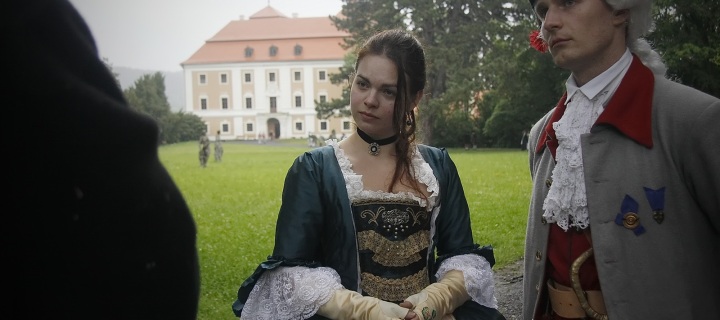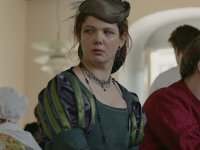The unexpected problems of a game stuffed with themes and plots and their working solutions.
 We made the most expensive game in Czech larp history, we had worked hard on it for a year and we had prepared almost 100 detailed pre-written characters. After the first two runs of the larp a lot of people said “It was alright.” This article is about searching for changes which would make the game better than “alright”.
We made the most expensive game in Czech larp history, we had worked hard on it for a year and we had prepared almost 100 detailed pre-written characters. After the first two runs of the larp a lot of people said “It was alright.” This article is about searching for changes which would make the game better than “alright”.
De la Bête was a larp inspired by the French legend about the Beast of Gévaudan. It captures 97 characters of hunters, prisoners, soldiers, merchants, scientists and nobles in 18th century France. Our goal as the authors was to make a two-day-long dramatic larp with minimum downtimes, a game with interesting plots, twists and dilemmas for each character. To assure this will indeed take place, we decided to use pre-written characters and design almost only personal plots, few group plots and no global plot with impact on all characters in the game. As a result we have written 110 plots, each directly involving on average four characters .
Pre-written characters and game filled with personal plots is in the Czech Republic a usual game design for chamber larps and is also quite common for dramatic larps up to 40 players. But it has never been consistently used for a game of such scale. The chosen design approach and the amount of content brought about several unexpected problems. We knew, that the number of personal plots will let us to a multi-thematic and also multi-genre game. In De la Bête you could find horror plots about the price for knowledge and secret societies, adventure haunting plots about friendship and rivalry as well as a romantic storyline about a young noble love triangle. We thought that the game is big enough to hold all the genres if all the players walk down the same (purely dramatic) road of the three way model. Well, basically we were right about the ability to hold the genres, but not about the way how to do it.
The Unexpected Complications
After the first two runs of the game we decided for a massive redesign. But firstly we had to analyse what were the weak spots of De la Bête. Among others, we found these problems to appear during the game.
Incoherent Plots
Each character was involved in app. 5 plots. Couple of players considered the plots and the character itself as incoherent. All motivations of character were clear for us, because we spent a lot of time sharpening them. But we hadn’t been able to communicate them correctly to all the players. And they didn’t ask. This lead to omitting of a few plots which players found unfitting. Of course, the character’s input to the plot was missing to other players.
Shallow Play
Few players had more plots than they were able to play. They ignored some of them as in previous case. But more often this lead the players to shallow play. They were more “doing” and less “acting and feeling”: Declare love, checked. Business meeting, checked. Confront the rival in love, checked. Break up, checked…
Inconsistent Subjective World
The design based on a huge number of plots resulted in inconsistent subjective game worlds. Basically, the players were overwhelmed by topics they came across during the game. Players thought: “It is fine that there is a haunted castle and night hunts, but a society of Freemasons? Come on… This is too much.” We didn’t realize during the game development how many personal plots will go public and that the players will have a problem to incorporate them to their subjective diegesis.
Out of Context
Even the scenes in the best movies could look stupid without proper introduction and when you don’t know the context. It is the same in a larp.A short personal story follows: Once, I was watching O’Connor’s Warrior and I was moved by the final fight scene. Suddenly, my wife came and she started laughing because she found the scene cheesy. She couldn’t get how emotional it is when Joel Edgerton strangles Tom Hardy while saying “It’s alright. I love you.” Even the scenes (or the whole topic) in the best movies could look stupid without proper introduction and when you don’t know the context. It is the same in a larp. We found how big problem this is when the end of the game was coming and most plots were going through catharsis. The players were shouting at each other, duelling, declaring love and dying. Everything in public as is expected from dramatic players. It led to over-escalated scenes without context, feeling of deaths inflation and no time to feel the impact of anything. This would not happen in a design with a global plot, where the catharsis touches every character.
New Game Style
 Most of the problems rose from the unfitting game approach. At the beginning of the game development we thought that the game style of De la Bête would be the same as for drama larps for 40 players. Honestly, we didn’t think a lot about it, we considered it as a clear thing. In Czech a “typical” drama player is someone who tends to : 1) play to lose, 2) tell the character’s secret to as many other players as possible, 3) play the tense scenes in front of as many other players as possible and 4) whose goal is to make each separate scene as dramatic as possible. It works very well in most larps, especially chamber ones.
Most of the problems rose from the unfitting game approach. At the beginning of the game development we thought that the game style of De la Bête would be the same as for drama larps for 40 players. Honestly, we didn’t think a lot about it, we considered it as a clear thing. In Czech a “typical” drama player is someone who tends to : 1) play to lose, 2) tell the character’s secret to as many other players as possible, 3) play the tense scenes in front of as many other players as possible and 4) whose goal is to make each separate scene as dramatic as possible. It works very well in most larps, especially chamber ones.
We didn’t notice during the development that the approach wasn’t suitable for De la Bête and that it would cause the complications mentioned above. So we grabbed the chance to change it for the third run. The new approach was our guiding principle for all pre-game documents and workshops and we did an extensive review of all game content because of it.The new idea was that De la Bête should be played as a novel. More specifically a big French historical novel such Dumas, Balzac or Hugo wrote. Every player is telling the story of the main character through the game. There will be a number of subplots and supporting characters, but the player shall focus on the development of the character’s overall story, where the character’s main theme plays a crucial role.
Main Theme
The theme was in some form a part of the characters from the beginning, but we decided to formulate it explicitly. This is an actual in-game example of a character’s theme:
Her main theme is the clash between responsibility to the community and personal happiness. She has to cope with the role of a moral authority, which is a new deal for her. New responsibilities and expectations are brought in her life. What it means to be the chosen one? How could she combine the responsibilities, which are arising from her position, and ordinary human happiness? And is it possible to love every creature of God and be fully committed to only one man at the same time?
The theme unified the character’s plots and brought depth to the game. The players were guided to think about the overall character’s story all the time: What my character did and how is it connected to my theme? How is my theme developing and where is my character aiming? The overall storyline of a character in De la Bête was more important than separate scenes. Therefore, the scene itself can be less intense and dramatic, but the overall feeling will be way more coherent and impressive (and also immersive). A part of this game approach was also the ability to incorporate everything in the game to one´s own personal story (and theme) or discard it as useless for the character’s storyline. It can be labelled as subjective narrativism, which would be a subset of dramatical approach.
The players were guided to think about the overall character’s story all the time.In the first two runs there were free organizers in the field ready to deal with players’ queries. For the third run we encouraged the players to talk about the story development with the organizers a couple times per day or at least to find the time to think about it. More frequent consultations were beneficial in several ways: 1) the players thought over their character story and theme, 2) we knew what was happening in the game, 3) we were able to discover mistakes (i.e. wrong times of meetings), 4) we had a chance to identify bored players in time and 5) we partially oversaw the psychological comfort of players. After a day of the game we named the consult room as the Heaven (because the organizers were in contact with thrilled and excited player) and the backstage as the Hell (where the organizers had to deal with problems).
In the pregame documents and workshops we tried to teach the players when, where and most importantly with / for whom they should play the catharsis of a character’s storyline. It should be the players who know the context and know what preceded the tense scene. During the 3rd run significantly less scenes took place in public and for example, deaths took place in family circles.
Outcome
 According to the post-game questionnaire there were in the first two runs 32 % of excited players, 40 % of satisfied ones, 13 % of players who considered the game average, 11 % below average and 1 % as a bad one. The third run has much better rates : 71 % of excited players, 27 % of satisfied players with only 2 % of players considering the game as average. Nobody labelled the game below average or bad. Of course, there are more aspects than the redesigning itself, but we believe that these changes significantly helped the game and solved the “unexpected complications”. The theme connected character’s plots and pointed out interesting thoughts in individual storylines. The “novel approach” helped the players recognise what, when and with whom should the game be played and it brought about a strong feeling of game integrity to them.
According to the post-game questionnaire there were in the first two runs 32 % of excited players, 40 % of satisfied ones, 13 % of players who considered the game average, 11 % below average and 1 % as a bad one. The third run has much better rates : 71 % of excited players, 27 % of satisfied players with only 2 % of players considering the game as average. Nobody labelled the game below average or bad. Of course, there are more aspects than the redesigning itself, but we believe that these changes significantly helped the game and solved the “unexpected complications”. The theme connected character’s plots and pointed out interesting thoughts in individual storylines. The “novel approach” helped the players recognise what, when and with whom should the game be played and it brought about a strong feeling of game integrity to them.
The problems raised in the first two runs are obvious to us now, but we had to work hard to discover them. And even if the “novel approach” originated as a secondary solution for this specific game, I believe that it could be successfully used in other larps.
All photos in this article by Lukáš Makovička.
De la Bête
Used Concepts: Pay and Play, Pre-written characters, traces of Fateplay, Act Structure, Persistent play, Aspiring to 360º illusion
Credits: Adam Pešta (chief of production); David František Wagner (chief of game design and writing); Kamil Buchtík, Ondřej Hartvich, Lucie Chlumská, Mikuláš Pešta, Petr Turoň (game design and writing); Alice Ďurčatová, Slaven Elčić, Iva Vávrová (PR); Tomáš Bazala, Eva Mlejnková (costumes); Vít Filipovský (website); Alena Kučerová (accounting); Michal Olbert (pre-game photos); Rosenthal o.s., Rolling and another 30 people.
Date:: 25–29 September 2013 1st run; 2–6 October 2013 2nd run; 28–31 May 2014 3rd run
Location: Valeč Castle, Czech Republic
Length: 2 days + 1 day of paralarp
Players: 97 per game
Budget: 1,000,000 CZK (36,000 €) for 3 runs
Participation Fee:: 1,800 – 2,600 CZK (65 – 95 €)
Website: www.delabete.cz
Photos: http://makovicka.net/galerie.php?lang=cs&g=140709 and http://makovicka.net/galerie.php?lang=cs&g=131025 and http://pwx.rajce.idnes.cz/De_La_Bete/






